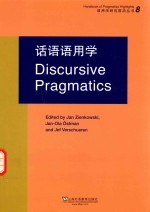图书介绍
话语语用学 英文2025|PDF|Epub|mobi|kindle电子书版本百度云盘下载

- 杰恩可夫斯基主编 著
- 出版社: 上海:上海外语教育出版社
- ISBN:9787544637404
- 出版时间:2014
- 标注页数:307页
- 文件大小:47MB
- 文件页数:333页
- 主题词:语用学-研究-英文
PDF下载
下载说明
话语语用学 英文PDF格式电子书版下载
下载的文件为RAR压缩包。需要使用解压软件进行解压得到PDF格式图书。建议使用BT下载工具Free Download Manager进行下载,简称FDM(免费,没有广告,支持多平台)。本站资源全部打包为BT种子。所以需要使用专业的BT下载软件进行下载。如BitComet qBittorrent uTorrent等BT下载工具。迅雷目前由于本站不是热门资源。不推荐使用!后期资源热门了。安装了迅雷也可以迅雷进行下载!
(文件页数 要大于 标注页数,上中下等多册电子书除外)
注意:本站所有压缩包均有解压码: 点击下载压缩包解压工具
图书目录
Discursive pragmatics:A platform for the pragmatic study of discourse&Jan Zienkowski1
Appraisal&Peter R.R.White14
1.Introduction14
2.Overview16
2.1 Attitude-the activation of positive or negative positioning16
2.1.1 Affect16
2.1.2 Judgement16
2.1.3 Appreciation17
2.1.4 Modes of activation-direct and implied17
2.1.5 Typological criteria18
2.1.6 The interplay between the attitudinal modes19
2.2 Intersubjective stance20
3.Attitudinal assessment-a brief outline21
3.1 Affect21
3.2 Judgement22
3.3 Appreciation25
4.Engagement:An overview27
4.1 Dialogic contraction and expansion28
4.2 Further resources of dialogic expansion29
4.2.1 Acknowledge30
4.2.2 Entertain30
4.3 Further resources of dialogic contraction30
4.3.1 Pronounce30
4.3.2 Concur31
4.3.3 Disclaim(Deny and Counter)31
4.3.4 Disclaim:Deny(negation)31
4.3.5 Disclaim:Counter32
4.4 Engagement resources-summary33
5.Conclusion33
Cohesion and coherence&Wolfram Bublitz37
1.Introduction37
2.Focus on form:Cohesion38
3.Cohesion as a condition for coherence40
4.Focus on meaning:Connectivity42
5.Semantic connectivity as a condition for coherence43
6.Coherence:A general view44
7.A hermeneutic,context and interpretation based view of coherence45
8.Coherence as a default assumption47
9.Perspectives47
Critical Linguistics and Critical Discourse Analysis&Ruth Wodak50
1.Definitions50
2.Historical note53
3.Principles of CL53
4.Trends55
4.1 Social Semiotics55
4.2 ‘Orders of discourse’and Foucauldian poststructuralism58
4.3 The socio-cognitive model60
4.4 Discourse-Historical approach61
4.5 Lexicometry62
4.6 "Lesarten"approach64
5.Conclusion65
?nonciation:French pragmatic approach(es)&Marjut Johansson ? Eija Suomela-Salmi71
1.Introduction71
2.Historical overview-from the pre-theoretical to the present phase72
2.1 Origins and the pre-theoretical phase72
2.2 First phase:Forerunners74
2.2.1 Charles Bally(1865-1947)74
2.2.2 Gustave Guillaume(1883-1960)78
2.3 Second phase:Main theoretical foundation80
2.3.1 Emile Benveniste(1902-1976)81
2.4 Third phase:Modern developments85
2.4.1 Antoine Culioli(born in 1924)85
2.4.2 Oswald Ducrot(born in 1930)88
2.4.3 Jacqueline Authier-Revuz(born in 1940)90
3.Some basic notions92
3.1 Enunciation and enunciator92
3.2 Situation/Context93
3.3 Subjectivity and deixis93
3.4 Reported speech94
3.5 Modality and modalization95
3.6 Modalities of enunciation(modalités d'énonciation)96
3.7 Utterance modalities(modalités d'énoncé)97
Figures of Speech&Manfred Kienpointner102
1.Introduction102
2.Ancient rhetoric102
3.Contemporary treatments of FSP104
3.1 Definition of FSP104
3.2 Classification of FSP108
4.Across the lines of discipline:The cognitive and communicative role of FSP111
Genre&Anna Solin119
1.Introduction119
2.Historical precedents120
3.Genre research in language studies121
3.1 Sydney School121
3.2 New Rhetoric123
3.3 English for Specific Purposes125
4.Issues and debates127
4.1 Genre as class127
4.2 Stability of genres129
Humor&Salvatore Attardo135
1.Introduction and definition135
2.Referential and verbal humor135
3.Semantics136
3.1 The isotopy-disjunction model136
3.2 The script-based semantic theory of humor137
3.3 ‘Longer’texts138
4.The cooperative principle and humor138
4.1 Grice and Gricean analyses138
4.2 Humor as non-bona-fide communication138
4.3 Relevance-theoretic approaches to humor139
4.4 Informativeness approach to jokes141
4.5 Two-stage processing of humor142
5.Conversation analysis143
5.1 Canned jokes in conversation143
5.1.1 Preface143
5.1.2 Telling143
5.1.3 Response144
5.2 Conversational humor144
5.2.1 Functional conversational analyses144
5.2.2 Quantitative conversational analyses145
6.Sociolinguistics of humor147
6.1 Gender differences147
6.2 Ethnicity and humor148
7.Computational humor148
8.Cognitive linguistics and humor149
9.Conclusion149
Intertextuality&Stef Slembrouck156
1.From‘literature’to‘text as a productivity which inserts itself into history’156
2.Text linguistics on‘textuality’157
3.Dialogism and heteroglossia in a social-diachronic theory of discourse158
4.Volo?inov,pragmatics and conversation analysis:Sequential implicativeness and the translation of the other's perspective162
5.Synoptic and participatory views of human activity:Bakhtin,Bourdieu,sociolinguistic legitimacy(and the body)165
6.Natural histories of discourse:Recontextualization/entextualization and textual ideologies170
Manipulation&Paul Chilton176
1.The ancient technique of rhetoric176
2.The twentieth-century nightmare of‘thought control’177
3.Manipulation is not inherent in language structure179
4.So let's look at thought and social action181
4.1 Drumming it in181
4.2 Ideas that spread182
5.What might override the cheat-checker?184
6.Conclusion:Manipulation and counter-manipulation186
Narrative&Alexandra Georgakopoulou190
1.Narrative as a mode of communication190
2.Referential properties192
3.Textual properties193
3.1 Narrative organization193
3.2 Narrative evaluation196
4.Contextual properties200
Polyphony&Eddy Roulet208
1.Preliminaries208
2.Polyphony in Bakhtin's work208
3.Polyphony in Ducrot's work212
4.The description of the polyphonic organization of discourse215
5.The interrelations between polyphony and other dimensions of discourse structures218
6.Conclusion221
Pragmatic markers&Karin Aijmer ? Anne-Marie Simon-Vandenbergen223
1.The tradition and the present state of research on pragmatic markers223
2.Definingthe field224
3.The terminology:Pragmatic marker or discourse marker?226
4.Classification227
5.Pragmatic markers and multifunctionality228
6.Theoretical approaches to the study of pragmatic markers229
7.Methodology231
8.Pragmatic markers in the languages of the world232
9.The diachronic study of pragmatic markers234
10.The contrastive study of pragmatic markers234
11.Pragmatic markers in translation studies236
12.Pragmatic markers in native versus non-native speaker communication236
13.Pragmatic markers and sociolinguistic aspects237
14.Pragmatic markers and the future238
Public discourse&Srikant Sarangi248
1.Introduction248
1.1 Multiple readings of‘publicness’249
2.The situation-talk dialectic:‘public’as a feature of setting vs.‘public’as a feature oftalk250
2.1 (Socio)linguistic markers of public discourse250
2.2 Interaction-based approach251
3.Goffman and the public order252
4.Habermas and the public sphere253
5.Transformation of the public sphere:Public discourse as mediated communication256
5.1 The state's role in the conflation of public and private discourses in contemporary societies258
5.2 Surveillance and control:Information exchange as a site of struggle259
6.Pragmatic theories of information exchange and the public sphere:Towards a social pragmatics260
Text and discourse linguistics&Jan-Ola ?stman?Tuija Virtanen266
1.On terminology266
2.Historical overview267
3.Important fields of study269
3.1 Information structure269
3.2 Cohesion270
3.3 Coherence271
3.4 Grounding273
3.5 Discourse types and genres274
4. Other trends276
5. Applications279
5.1 Practical applications280
5.2 Acquisitional and diachronic studies280
6.Final remarks281
Text linguistics&Robert de Beaugrande286
1.The rise of text linguistics286
2.Some central issues294
Index297